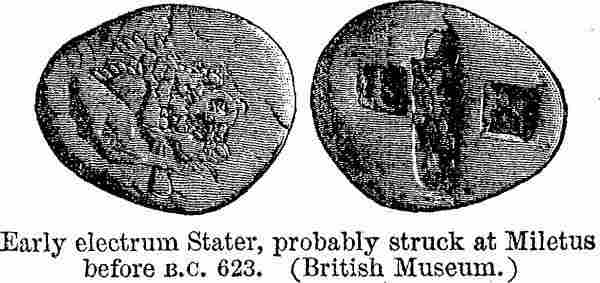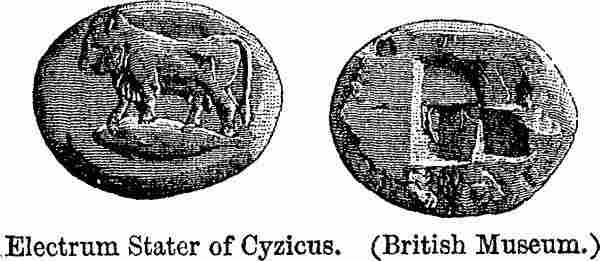.
ELECTRUM ἤλεκτρος or ἤλεκτρον. Lepsius has maintained (Ueber die Metalle in den Aegypt. Inschriften, Appendix) that the early Greek usage was to employ the masculine form when the mixture of gold and silver was intended; the neuter form when the mineral which we call amber was meant. It is likely that the Greeks were acquainted in very early times with the use of amber, trade in this mineral having taken place in pre-historic days between North and South Europe. They must also have been early acquainted with the compounded metal, since gold alike in Asia and Europe is commonly found mixed with silver. Which of the two substances therefore was first called electrum is a matter quite open to dispute. We will speak of them in turn.
(1) Amber. Beads of amber were found in the royal tombs at Mycenae; and chemical analysis (Schliemann, Tiryns, p. 370) has proved that this amber came from the Baltic, and not from elsewhere. Similar beads have also been found in the very early Greek (?) tombs at Ialysus in Rhodes. At a later period amber is mentioned in the Odyssey (15.460); 18.295) as a material of necklaces, which are said to be held together ἠλέκτροισι, by beads of amber. In one of these passages the necklace is spoken of as an import from Phoenicia. It is also stated (4.73) that the walls of the palace of Menelaus were adorned with amber, as well as gold, silver, and ivory. The author of the Shield of Herakles, ascribed to Hesiod, speaks of that shield (141) as adorned with electrum, in which case, however, the metal may be meant. In South Italy amber was in the archaic period used as a material for statuettes and reliefs; many specimens of this kind of work are in the British Museum. But the amber used in Italy seems to differ in many respects from that of the Baltic, and is more like the amber still found in small quantities in Sicily.
Many writers have maintained that there was a regularly used trade-route across Europe from the banks of the Baltic to the shores of the Euxine or Adriatic, by which amber was brought to the south in exchange for other wares, and that this route was used without intermission from prehistoric days onwards. But the only facts on which this view is based are the occasional discovery in Central Europe of the coins and art-products of Greece and Etruria, and the above-mentioned presence of pieces of amber in early Greek tombs. These facts are, as Furtwängler remarks (Goldfund von Vettersfelde, p. 49) not conclusive. It is more probable that the amber of early Greece was imported by the Phoenicians who sailed round the coast to the north of Europe, especially in view of the fact that after the Homeric age amber disappears from Greek tombs, and does not again figure until Roman times, when a regular trade with the Baltic coast had sprung up.
(2) Mixed gold and silver. The earliest certain mention of this mixed metal as electrum (rather ἤλεκτρος) is in Sophocles' Antigone, 1037, where the substance is said to come from Sardes: for Sardes by the Pactolus was noted in antiquity as the place whence came the river-gold, mixed when found with a considerable percentage of silver. Herodotus, however, speaking of this same Sardian metal in connexion with the donaria of Croesus to Delphi (1.50), calls it white gold, λευκὸς χρυσός. Pliny remarks (H. N. 33.80) that gold is invariably found mixed with silver (which is true), and that when the proportion of silver reaches a fifth, the metal is called electrum. He adds that electrum was made by art as well as found.
This white gold or electrum is used on the sword-blades found at Mycenae for purposes of inlaying. In later times it was used, as being a harder material than gold, for objects in which hardness was desirable. By far the most important use to which it was put was as a material for coins.
In the 7th century B.C., or possibly late in the 8th, the kings of Lydia began to issue stamped. money of electrum, using probably the metal in its natural state, and the maritime cities of the Asiatic coast and of Euboea adopted the idea. Information as to the standards of weight used

Early electrum Stater, probably struck at Miletus before B.C. 623. (British Museum.)
in these issues is given under PONDERA For some time, until silver was first minted at Aegina, all the coinage of the world consisted of stamped pellets of electrum, though no doubt unstamped bars of gold and silver circulated with them. It is observed by Mr. Head (Numismatic Chronicle, 1875, p. 254), in his excellent account of early electrum coins, which is mainly based on the researches of Brandis (Münz-Mass-und Gewichtswesen), that the mixed metal had two advantages over pure gold in circulation: (1) it was more durable; (2) the proportionate value of gold to silver being 13 1/3 to 1 (Herodotus says 13), and electrum being of three-fourths the value of gold, each coin of electrum would pass as the equivalent of ten silver bars of equal weight. It is considered that this proportion is shown to have actually held by the fact that everywhere electrum was minted on the standards of weight in use for silver, and not on the (different) standards in use for gold, which seems to show that the proportionate values of electrum and silver were very simple. It must, however, be cited as an objection to the views of Brandis and Head, that in the cases in which the proportion of gold to silver in electrum coins has been determined by chemical analysis or specific gravity, a far less proportion of gold than three to one has been discovered, a proportion indeed sometimes less than one to one, so that it is difficult to see how electrum can have been considered as of three-fourths of the value of gold. On this subject further investigations are necessary.
It is believed that Croesus first introduced in Asia, in place of the coinage of electrum, money [p. 1.715]of gold and of silver. The conquering Persian kings adopted the Lydian currency and imitated it, and coins of electrum went rapidly out of use. But at a somewhat later time, about B.C. 500, electrum was again issued by a few cities, more especially Cyzicus, Phocaea,and Lampsacus.

Electrum Stater of Cyzicus. (British Museum.)
The staters and hectae (sixths) of those cities were current in the Euxine, Asia Minor, and Greece. They are mentioned in Attic inscriptions from B.C. 434 onwards. Cyrus the younger paid his Greek mercenaries a Cyzicene stater a month (Xenoph. Anab. 7.3, 10), and Demosthenes states in his speech against Phormio (B.C. 333) that in Pontus Cyzicene staters passed as equivalent to 28 Attic drachms of silver. [See STATER]
We possess the text of a curious commercial treaty concluded between Phocaea and Mytilene, for the issue in common by the two states of hectae or sixths of electrum. For the details, see Newton in Trans. Roy. Soc. Lit. viii. p. 549. Each of the cities was in turn for the space of a year to mint these coins, which were to be in both a legal tender, and provisions were made for punishing any person who debased the currency below the normal standard. But the paleness of these hectae, which still exist in large numbers, proves that they did not contain a high proportion of gold. In the fourth century, electrum coins were largely used at Carthage, and in the time of Timoleon at Syracuse.
Dictionary of Greek and Roman Antiquities
| Ancient Greece
Science, Technology , Medicine , Warfare, , Biographies , Life , Cities/Places/Maps , Arts , Literature , Philosophy ,Olympics, Mythology , History , Images Medieval Greece / Byzantine Empire Science, Technology, Arts, , Warfare , Literature, Biographies, Icons, History Modern Greece Cities, Islands, Regions, Fauna/Flora ,Biographies , History , Warfare, Science/Technology, Literature, Music , Arts , Film/Actors , Sport , Fashion --- |


